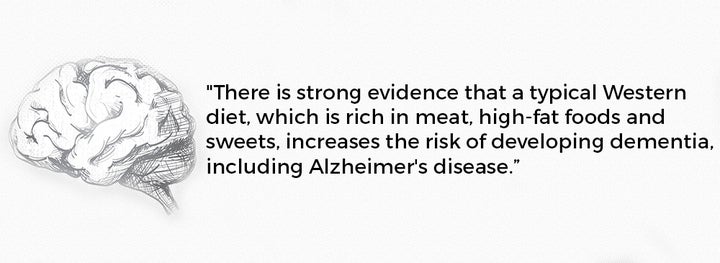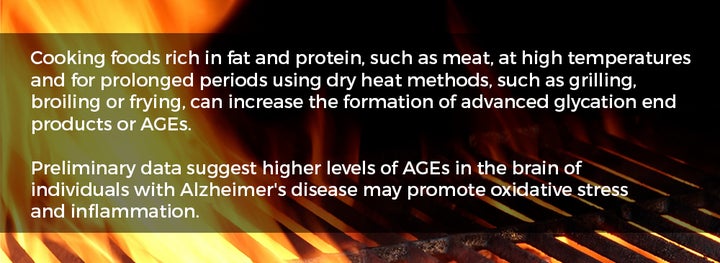You’ve heard time and again that it’s not wise to eat too much red meat, especially if processed, since higher intakes are linked with increased risks of obesity, cardiovascular disease, type 2 diabetes and several cancers. A growing number of studies suggest dietary patterns high in meat may promote cognitive decline, too.
“There is strong evidence that a typical Western diet, which is rich in meat, high-fat foods and sweets, increases the risk of developing dementia, including Alzheimer’s disease,” says Tammy Scott, PhD, assistant professor at the Friedman School or Nutrition Science and Policy at Tufts University and a scientist in the Neuroscience and Aging Laboratory at the Jean Mayer USDA Human Nutrition Research Center on Aging. Observational research has tried to pinpoint which components of Western diets are the biggest contributors to increased risk of Alzheimer’s disease, but these data do not represent “cause and effect” and therefore should be interpreted with caution.
Meat and Alzheimer’s Disease
Red meat made headlines recently as a food that may raise Alzheimer’s disease risk. These news stories were based on a study published in the Journal of the American College of Nutrition. The analysis included 10 countries: the United States, Brazil, Chile, Cuba, Egypt, India, Mongolia, Nigeria, Republic of Korea and Sri Lanka.

Assessed was the per capita food supply of these countries in the five-, 10- and 15-year periods leading up to a diagnosis of Alzheimer’s disease. A higher per capita country-wide supply of meat and other animal products (except milk) in the five years prior to diagnosis had the strongest association with Alzheimer’s disease risk. However, it’s important to realize such research cannot pinpoint which segments of the populations were eating the most meat and other animal products, or of those who were, whether they were the ones that had the highest rates of Alzheimer’s disease.
What Is It About Meat?
If a high meat intake does increase Alzheimer’s disease risk, why might that be? Diets high in saturated fat, such as from meat, may promote insulin resistance, which is a risk factor for Alzheimer’s disease. “Another way eating large amounts of meat may increase Alzheimer’s disease risk is by increasing your intake of trace metals, such as copper and iron, that in excess have been shown to promote oxidative damage ― particularly in older adults,” Scott (who was not involved in the study) explains.
Although plant foods also contain copper and iron, these minerals are much better absorbed from meat, so people may get more than they need if they over-consume meat. Notably, levels of heme iron (a more absorbable form) are 8 to 10 times higher in red meat than in poultry. “This may contribute to excess intake of these essential minerals since people also may ingest them in dietary supplements and as contaminants in drinking water, such as from plumbing,” Scott says. “Genetic variations in a person’s ability to metabolize these minerals may also contribute to higher levels.”

Tip: If using dry-heat cooking (such as grilling, broiling, roasting, searing, stir-frying or pan-frying), marinate meat in something acidic, such as with lemon juice or vinegar, for one hour before cooking to help reduce advanced glycation end products (AGEs) formation. Use moist-heat cooking methods for meat and poultry more often, such as stewing and steaming (for example, by wrapping meat in parchment paper). This results in less formation of AGEs.
Another consideration: Cooking foods rich in fat and protein, such as meat, at high temperatures and for prolonged periods using dry heat methods, such as grilling, broiling or frying, can increase the formation of advanced glycation end products or AGEs. Preliminary data suggest higher levels of AGEs in the brain of individuals with Alzheimer’s disease may promote oxidative stress and inflammation.
In contrast, plant-based foods, such as vegetables, fruits, legumes and whole grains, contain relatively few AGEs, even after cooking. These are the same types of foods that are linked with lower risk of Alzheimer’s disease and that are more environmentally friendly than meat, making them good choices. So, the best approach is to enjoy these plant foods often as part of your eating pattern balanced with fish, skinless poultry and smaller quantities of lean meat.
Take Charge and Learn More
You don’t have to give up meat, but you can eat it sensibly. Follow these guidelines:
- Limit red meat to fewer than four servings (3 ounces each) per week, preferably lean cuts. Examples of red meat are beef, pork, bison, lamb, goat and game meat, such as elk and venison.
- Lean cuts are often signaled by the words “loin” and “round,” such as sirloin steak from beef, eye of round roast from elk and tenderloin cuts from pork, venison or lamb.
- Avoid processed meats, which are often high in saturated fat, sodium and nitrates. Examples are sausage, bacon, ham, hot dogs, salami, bologna and beef jerky.
- Use smaller amounts of meat as an ingredient in dishes rather than the focal point of the meal. For instance, use a bit of meat in vegetable-rich soup, stir-fry dishes or to top a salad.
- If using dry-heat cooking (such as grilling, broiling, roasting, searing, stir-frying or pan-frying), marinate meat in something acidic, such as with lemon juice or vinegar, for one hour before cooking to help reduce AGEs formation.
- Use moist-heat cooking methods for meat and poultry more often, such as stewing and steaming (for example, by wrapping meat in parchment paper). This results in less formation of AGEs.
- Try “Meatless Mondays.” That day, enjoy plant protein sources, such as lentil soup, baked tofu, vegetarian chili or three bean salad.
- Try eating more fish: Fish Linked to Less Alzheimer’s Disease in Those Most at Risk.
Article Glossary
Saturated fat – Saturated fat is a type of fat found mostly in animal products like meat and dairy but also tropical oils, such as coconut and palm, that has a strong association with increased cholesterol. Relevance ― Raised blood cholesterol resulting from high saturated fat intake can increase risk of heart disease and stroke, so foods high in saturated fat like whole-milk dairy, full-fat cheese, ice cream, butter, meat, and tropical oils should be limited in the diet.
Copper – Copper is a trace mineral that is essential to the body and found in all tissues. Relevance ― Copper, along with iron, helps produce red blood cells and supports nerve, bone, blood vessel and immune health; copper is found in shellfish, whole grains, beans, nuts, and organ meats.
Iron – Iron is a mineral needed by the body as a component of hemoglobin, which transports oxygen from the lungs to the rest of the body through the blood, and also to help the muscles store and use oxygen. Relevance ― Low iron levels in the body can lead to iron deficiency anemia, caused by poor diet, blood loss, or poor absorption of iron; while too much iron, often from supplements, can cause iron poisoning.
Whole grain – Whole grains are the entire edible kernel of a plant, consisting of the outermost bran, the embryo germ, and the endosperm as the germ’s food supply. Relevance ― Whole grains contain all three components of the kernel and are unrefined, meaning that they maintain B vitamins, protein, fiber, antioxidants, minerals and other vitamins that are often lost during processing of refined grains.
This article was originally published in the January 2017 edition of the Tufts Health & Nutrition Letter, a publication of the Friedman School of Nutrition Science & Policy at Tufts University: Editor-in-Chief, Dariush Mozaffarian, MD, DrPH, and Executive Editor, Alice H Lichtenstein, DSc.
The Gerald J. and Dorothy R. Friedman School of Nutrition Science and Policy is the only graduate school of nutrition in the United States. The mission of the school is to generate trusted science, educate future leaders, and produce real world impact.